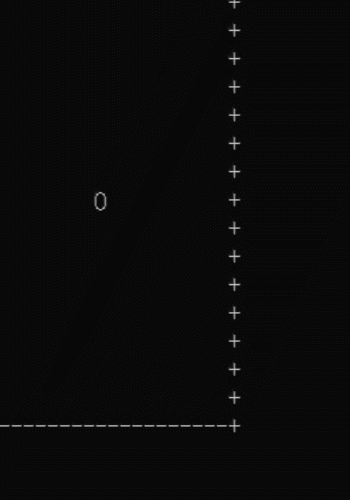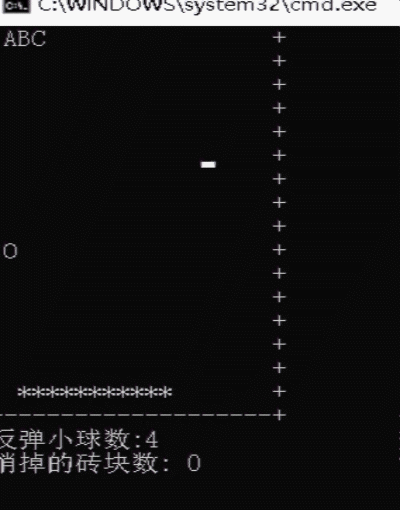溫馨提示×
您好,登錄后才能下訂單哦!
點擊 登錄注冊 即表示同意《億速云用戶服務條款》
您好,登錄后才能下訂單哦!
本篇內容介紹了“C語言中怎么用函數實現反彈球消磚塊”的有關知識,在實際案例的操作過程中,不少人都會遇到這樣的困境,接下來就讓小編帶領大家學習一下如何處理這些情況吧!希望大家仔細閱讀,能夠學有所成!
這是在上一次彈跳小項目上進行了一系列的優化和封裝。項目: 彈跳的小球
上次沒有用函數進行的封裝。這次在上次的基礎上進行封裝和一些功能的優化。
最終效果圖如下:

代碼如下:
#include<stdio.h>
#include<string.h>
#include<conio.h>
#include<windows.h>
//全局變量
int high,width; //游戲畫面大小
int ball_x,ball_y;//小球的坐標
int ball_vx,ball_vy;//小球的速度
void gotoxy(int x,int y)//將光標移動到(x,y)位置
{
HANDLE handle = GetStdHandle(STD_OUTPUT_HANDLE);
COORD pos;
pos.X = x;
pos.Y = y;
SetConsoleCursorPosition(handle,pos);
}
void startup()//數據的初始化
{
high = 15;
width = 20;
ball_x = 0;
ball_y = width/2;
ball_vx = 1;
ball_vy = 1;
}
void show()//顯示畫面
{
gotoxy(0,0);//光標移動到原點位置,以下重畫清屏
int i,j;
for(i=0;i<=high;i++)
{
for(j=0;j<=width;j++)
{
if( ( i == ball_x) && ( j == ball_y ) )
printf("O");//輸出小球
else if( j == width)
printf("+");//輸出右邊框
else if( i == high)
printf("-");//輸出下邊框
else
printf(" ");//輸出空格
}
printf("\n");
}
}
void updateWithoutInput()//與用戶輸入無關的更新
{
ball_x = ball_x + ball_vx;
ball_y = ball_y + ball_vy;
if( (ball_x == 0 ) || (ball_x == high-1 ))
ball_vx = -ball_vx;
if( (ball_y == 0 ) || (ball_y == width-1 ))
ball_vy = -ball_vy;
Sleep(50);
}
void updateWithInput()//與用戶輸入有關的更新
{
}
int main(void)
{
startup();//數據的初始化
while(1)
{
show();//顯示畫面
updateWithoutInput();//與用戶輸入無關的更新
updateWithInput();//與用戶輸入有關的更新
}
return 0;
}效果圖如下:

代碼如下:
#include<stdio.h>
#include<string.h>
#include<conio.h>
#include<windows.h>
//全局變量
int high,width; //游戲畫面大小
int ball_x,ball_y;//小球的坐標
int ball_vx,ball_vy;//小球的速度
int position_x,position_y;//擋板的中心坐標
int ridus;//擋板的半徑大小
int left,right;//擋板的左右位置
void gotoxy(int x,int y)//將光標移動到(x,y)位置
{
HANDLE handle = GetStdHandle(STD_OUTPUT_HANDLE);
COORD pos;
pos.X = x;
pos.Y = y;
SetConsoleCursorPosition(handle,pos);
}
void startup()//數據的初始化
{
high = 15;
width = 20;
ball_x = 0;
ball_y = width/2;
ball_vx = 1;
ball_vy = 1;
ridus = 5;
position_x = high;
position_y = width/2;
left = position_y -ridus;
right = position_y + ridus;
}
void show()//顯示畫面
{
gotoxy(0,0);//光標移動到原點位置,以下重畫清屏
int i,j;
for(i=0;i<=high+1;i++)
{
for(j=0;j<=width;j++)
{
if( ( i == ball_x) && ( j == ball_y ) )
printf("O");//輸出小球
else if( j == width)
printf("+");//輸出右邊框
else if( i == high+1)
printf("-");//輸出下邊框
else if ( (i==high)&&(j>=left)&&(j<=right))
printf("*");
else
printf(" ");//輸出空格
}
printf("\n");
}
}
void updateWithoutInput()//與用戶輸入無關的更新
{
ball_x = ball_x + ball_vx;
ball_y = ball_y + ball_vy;
if( (ball_x == 0 ) || (ball_x == high-1 ))
ball_vx = -ball_vx;
if( (ball_y == 0 ) || (ball_y == width-1 ))
ball_vy = -ball_vy;
Sleep(50);
}
void updateWithInput()//與用戶輸入有關的更新
{
char input;
if(kbhit())
{
input = getch();
if( input == 'a' || input == 'A' )
{
position_y--;//位置左移
left = position_y-ridus;
right = position_y+ridus;
}
if( input == 'd' || input == 'D' )
{
position_y++;
left = position_y - ridus;
right = position_y + ridus;
}
}
}
int main(void)
{
startup();//數據的初始化
while(1)
{
show();//顯示畫面
updateWithoutInput();//與用戶輸入無關的更新
updateWithInput();//與用戶輸入有關的更新
}
return 0;
}效果圖如下:

代碼如下:
#include<stdio.h>
#include<string.h>
#include<conio.h>
#include<windows.h>
//全局變量
int high,width; //游戲畫面大小
int ball_x,ball_y;//小球的坐標
int ball_vx,ball_vy;//小球的速度
int position_x,position_y;//擋板的中心坐標
int ridus;//擋板的半徑大小
int left,right;//擋板的左右位置
int ball_number;//反彈小球的次數
void gotoxy(int x,int y)//將光標移動到(x,y)位置
{
HANDLE handle = GetStdHandle(STD_OUTPUT_HANDLE);
COORD pos;
pos.X = x;
pos.Y = y;
SetConsoleCursorPosition(handle,pos);
}
void startup()//數據的初始化
{
high = 15;
width = 20;
ball_x = 0;
ball_y = width/2;
ball_vx = 1;
ball_vy = 1;
ridus = 5;
position_x = high;
position_y = width/2;
left = position_y -ridus;
right = position_y + ridus;
ball_number=0;
}
void show()//顯示畫面
{
gotoxy(0,0);//光標移動到原點位置,以下重畫清屏
int i,j;
for(i=0;i<=high+1;i++)
{
for(j=0;j<=width;j++)
{
if( ( i == ball_x) && ( j == ball_y ) )
printf("O");//輸出小球
else if( j == width)
printf("+");//輸出右邊框
else if( i == high+1)
printf("-");//輸出下邊框
else if ( (i==high)&&(j>=left)&&(j<=right))
printf("*");
else
printf(" ");//輸出空格
}
printf("\n");
}
printf("反彈小球數:%d\n",ball_number);
}
void updateWithoutInput()//與用戶輸入無關的更新
{
if( ball_x == high -1)
{
if( (ball_y>=left) && (ball_y<=right) )
{
ball_number++;
printf("\a");//響鈴
}
else
{
printf("游戲失敗\n");
system("pause");
exit(0);
}
}
ball_x = ball_x + ball_vx;
ball_y = ball_y + ball_vy;
if( (ball_x == 0 ) || (ball_x == high-1 ))
ball_vx = -ball_vx;
if( (ball_y == 0 ) || (ball_y == width-1 ))
ball_vy = -ball_vy;
Sleep(50);
}
void updateWithInput()//與用戶輸入有關的更新
{
char input;
if(kbhit())
{
input = getch();
if( input == 'a' || input == 'A' )
{
position_y--;//位置左移
left = position_y-ridus;
right = position_y+ridus;
}
if( input == 'd' || input == 'D' )
{
position_y++;
left = position_y - ridus;
right = position_y + ridus;
}
}
}
int main(void)
{
startup();//數據的初始化
while(1)
{
show();//顯示畫面
updateWithoutInput();//與用戶輸入無關的更新
updateWithInput();//與用戶輸入有關的更新
}
return 0;
}效果圖如下:

代碼如下:
#include<stdio.h>
#include<string.h>
#include<conio.h>
#include<windows.h>
//全局變量
int high,width; //游戲畫面大小
int ball_x,ball_y;//小球的坐標
int ball_vx,ball_vy;//小球的速度
int position_x,position_y;//擋板的中心坐標
int ridus;//擋板的半徑大小
int left,right;//擋板的左右位置
int ball_number;//反彈小球的次數
int block_x1,block_y1;//磚塊1的位置
int block_x2,block_y2;//磚塊2的位置
int block_x3,block_y3;//磚塊3的位置
int score;//消掉磚塊的個數
void gotoxy(int x,int y)//將光標移動到(x,y)位置
{
HANDLE handle = GetStdHandle(STD_OUTPUT_HANDLE);
COORD pos;
pos.X = x;
pos.Y = y;
SetConsoleCursorPosition(handle,pos);
}
void startup()//數據的初始化
{
high = 15;
width = 20;
ball_x = 0;
ball_y = width/2;
ball_vx = 1;
ball_vy = 1;
ridus = 5;
position_x = high;
position_y = width/2;
left = position_y -ridus;
right = position_y + ridus;
ball_number=0;
block_x1 = 0;
block_y1 = 1;
block_x2 = 0;
block_y2 = 2;
block_x3 = 0;
block_y3 = 3;
score=0;
}
void show()//顯示畫面
{
gotoxy(0,0);//光標移動到原點位置,以下重畫清屏
int i,j;
for(i=0;i<=high+1;i++)
{
for(j=0;j<=width;j++)
{
if( ( i == ball_x) && ( j == ball_y ) )
printf("O");//輸出小球
else if( j == width)
printf("+");//輸出右邊框
else if( i == high+1)
printf("-");//輸出下邊框
else if ( (i==high)&&(j>=left)&&(j<=right))
printf("*");
else if( (i==block_x1) && (j==block_y1) )
printf("A");//輸出磚塊1
else if( (i==block_x2) && (j==block_y2) )
printf("B");//輸出磚塊2
else if( (i==block_x3) && (j==block_y3) )
printf("C");//輸出磚塊3
else
printf(" ");//輸出空格
}
printf("\n");
}
printf("反彈小球數:%d\n",ball_number);
printf("消掉的磚塊數: %d\n",score);
}
void updateWithoutInput()//與用戶輸入無關的更新
{
if( ball_x == high -1)
{
if( (ball_y>=left) && (ball_y<=right) )//被擋板擋住了
{
ball_number++;
printf("\a");//響鈴
}
else
{
printf("游戲失敗\n");
system("pause");
exit(0);
}
}
if( (ball_x == block_x1) && (ball_y ==block_y1) )//小球擊中磚塊1
{
score++;//分數加1
block_y1=rand()%width;//產生新的磚塊
while((block_y1==block_y2) || ( block_y1==block_y3))
//當新產生的磚塊和其他磚塊重合時
{
block_y1=rand()%width;//產生新的磚塊
}
}
if( (ball_x == block_x2) && (ball_y ==block_y2) )//小球擊中磚塊2
{
score++;//分數加1
block_y2=rand()%width;//產生新的磚塊
while((block_y2==block_y1) || ( block_y2==block_y3))
//當新產生的磚塊和其他磚塊重合時
{
block_y2=rand()%width;//產生新的磚塊
}
}
if( (ball_x == block_x3) && (ball_y ==block_y3) )//小球擊中磚塊3
{
score++;//分數加1
block_y3=rand()%width;//產生新的磚塊
while((block_y3==block_y1) || ( block_y3==block_y2))
//當新產生的磚塊和其他磚塊重合時
{
block_y3=rand()%width;//產生新的磚塊
}
}
ball_x = ball_x + ball_vx;
ball_y = ball_y + ball_vy;
if( (ball_x == 0 ) || (ball_x == high-1 ))
ball_vx = -ball_vx;
if( (ball_y == 0 ) || (ball_y == width-1 ))
ball_vy = -ball_vy;
Sleep(66);
}
void updateWithInput()//與用戶輸入有關的更新
{
char input;
if(kbhit())
{
input = getch();
if( input == 'a' || input == 'A' )
{
position_y--;//位置左移
left = position_y-ridus;
right = position_y+ridus;
}
if( input == 'd' || input == 'D' )
{
position_y++;
left = position_y - ridus;
right = position_y + ridus;
}
}
}
int main(void)
{
startup();//數據的初始化
while(1)
{
show();//顯示畫面
updateWithoutInput();//與用戶輸入無關的更新
updateWithInput();//與用戶輸入有關的更新
}
return 0;
}效果圖如下:

“C語言中怎么用函數實現反彈球消磚塊”的內容就介紹到這里了,感謝大家的閱讀。如果想了解更多行業相關的知識可以關注億速云網站,小編將為大家輸出更多高質量的實用文章!
免責聲明:本站發布的內容(圖片、視頻和文字)以原創、轉載和分享為主,文章觀點不代表本網站立場,如果涉及侵權請聯系站長郵箱:is@yisu.com進行舉報,并提供相關證據,一經查實,將立刻刪除涉嫌侵權內容。